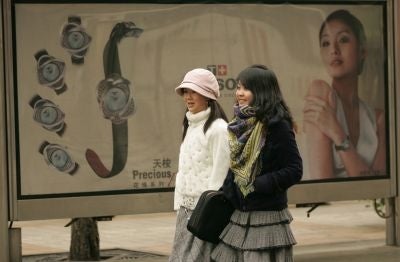Your support helps us to tell the story
From reproductive rights to climate change to Big Tech, The Independent is on the ground when the story is developing. Whether it's investigating the financials of Elon Musk's pro-Trump PAC or producing our latest documentary, 'The A Word', which shines a light on the American women fighting for reproductive rights, we know how important it is to parse out the facts from the messaging.
At such a critical moment in US history, we need reporters on the ground. Your donation allows us to keep sending journalists to speak to both sides of the story.
The Independent is trusted by Americans across the entire political spectrum. And unlike many other quality news outlets, we choose not to lock Americans out of our reporting and analysis with paywalls. We believe quality journalism should be available to everyone, paid for by those who can afford it.
Your support makes all the difference.It seems the Hong Kong and mainland Chinese watch markets are the prime movers behind keeping the historic Swiss watch industry ticking along - in more ways than one.
Hong Kong leads the way in terms of importing Swiss watches to an individual market - recording turnover of 1.4 million euros in the first eight months of the year, according to figures from the Federation of the Swiss Watch Industry (http://www.fhs.ch) - while China has moved into third behind the USA and France over that time thanks to a rise in imports of 63.3 percent (for a value of 487 million euros).
What's more, though, Swiss watchmakers turn East when they look for the components that make up their timepieces. They may well be "Swiss made'' but US$2.05 billion (1.5 billion euros) worth of watches and related components were imported to Switzerland last year - and 26 percent of those materials came from Hong Kong and China.
"To a great extent Hong Kong and China are what keeps the entire Swiss watch industry ticking, both as retail markets and component suppliers,'' CLSA consumer analyst Aaron Fischer told the South China Morning Post.
To counteract any bad press about the trend - and to ensure the "Swiss made'' legend remains - the Swiss government is considering legislation that will require local content to account for between 60 to 80 percent of the watch's value, including the cost of components, research and design. The law is designed to also protect other iconic Swiss exports such as cheese and chocolate.
The two countries are meanwhile exploring a bilateral free-trade arrangement which will have provisions for attacking the counterfeit "Swiss made'' market in China. The Post report claimed that of one million fake Swiss watches seized globally last year, 600,000 came from China.
And the Chinese are busy establishing a legitimate watch industry of their own - and are looking to the Swiss for a little help. The country's largest watchmaker, China Haidan Holding, has recently turned to an unnamed Swiss company to help with the development of its luxury "CodeX'' brand which it hopes to sell in - you guessed it - a flagship store in the Swiss city of Lucerne.
MS

Join our commenting forum
Join thought-provoking conversations, follow other Independent readers and see their replies
Comments